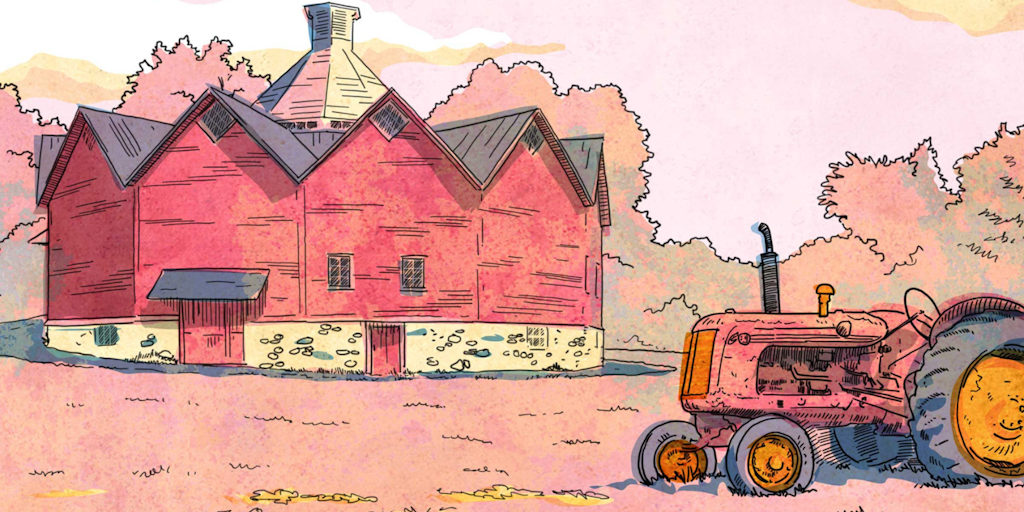The Appalachian Foothills
In the heart of these rolling plains and vastly eroded slopes of the Appalachian foothills, we find the birthplace of Quebec’s viticulture.


A Heritage Walk
It is also here in these vast agroforestry landscapes, spanning from the Canada-US border, that we discover a wealth of examples of the region’s built heritage. Towns such as Stanbridge East, Mystic, Bedford and Pigeon Hill all offer fine representations of our past. The region’s architectural build testifies to the Eastern Townships’ cultural and industrial history and origins.
In fact, the west-central sector of the MRC of Brome-Missisquoi teems with scenic routes. Throughout the countryside of Stanbridge, the Armandois hills offer bucolic roads set under canopies of century-old trees. More to the north, the setting for the towns of Farnham, Cowansville and Dunham, features landscapes where cattle and dairy farms invite themselves to graze on their slate plains.

Landscapes Sculpted by Limestone and Slate
The soil of the Appalachian foothills is largely composed of fluvio-glacial till sediments, remnants from the different glaciations. In the north, the landscape is characterized by slate deposits, conducive for wine-growing. To the south, limestone deposits form the core of the Stanbridge surroundings and Philipsburg scale. This scale is in fact a regional peculiarity primarily caused by tectonic activity that occurred here.
Today, quarries are thriving in the area, while the more rugged landscapes remain covered with forests. Throughout the foothills, the Champlain Sea waters’ action stirred up surface deposits making the silty and sandy bottom of this ancient sea conducive for agricultural activities. Other sectors where granular deposits abound were taken over by woodlands.

The Birthplace of the Townships
It was not until the third quarter of the 18th century that the first settlers, mainly Loyalists from the United States, arrived in the Brome-Missisquoi territory. Among several known reasons, this late settlement was the result of the geopolitical uncertainty caused by the Conquest of New France (1759–1763) and the American Independence war (1776–1783), and an unclear border between the two countries. The settlers first established themselves in the Missisquoi Bay sector, which later became Philipsburg.
Throughout this period, the territory was developed according to the British Townships model. The arrival of the railways, towards the end of the 19th century, would accelerate the development of the foothills. In 1884, eight railway companies crisscrossed the southern part of Quebec, making the Appalachian foothills one of Canada’s most densely covered areas by railways.

Cheers
There was a time when the Appalachian foothills abounded with industrial enterprises. By 1871, more than 245 companies had established themselves in the region. The most important among these were the Stanbridge flour and saw mills, the Dunham and Bedford tanneries, Saint-Armand’s wool, Bedford’s axe, and Cowansville’s clothing factories.
Today, the foothills are synonymous with agritourism. Small-scale farming models are becoming more and more popular. In the early 1980s, with the development of the wine industry here, the region acquired a whole new identity, beginning with the Dunham sector where Brome-Missisquoi’s first commercial vineyard was established. Since then, these rocky valleys and an ideal microclimate have provided the perfect landscape for more than a dozen vineyards.

Sought-after Soil
With its rich cultural landscapes, the Appalachian foothills are also subject to several preservation challenges. In the southern section, an expanding exploitation of limestone resources is causing conflicts between developers and those who wish to maintain the area’s heritage and agroforestry landscapes.
In the northern sector, the panoramas of the slate plains are threatened by urban sprawl. Routes 139 and 104 were created to lead traffic away from town centres (Adamsville, East Farnham, Cowansville). Today, downtown neighbourhood activities have relocated to these wide boulevards. This displacement has also brought about the emergence of scattered suburban subdivisions throughout the countryside. In 2019, the Entre-Yamaska sector alone, which includes Granby, Bromont, Saint-Alphonse-de-Granby, Brigham, East Farnham and Cowansville, counted 105,000 residents with homes spread along an almost continuous urbanization corridor.




